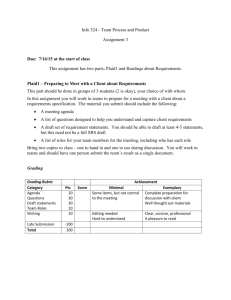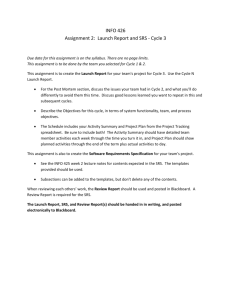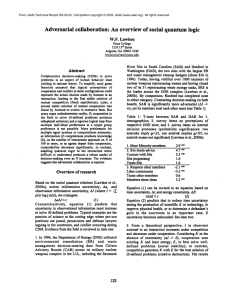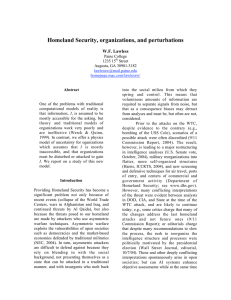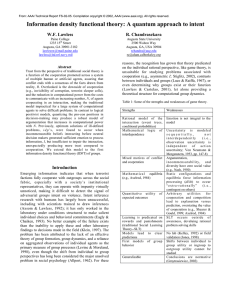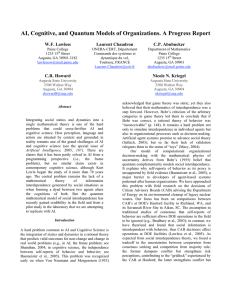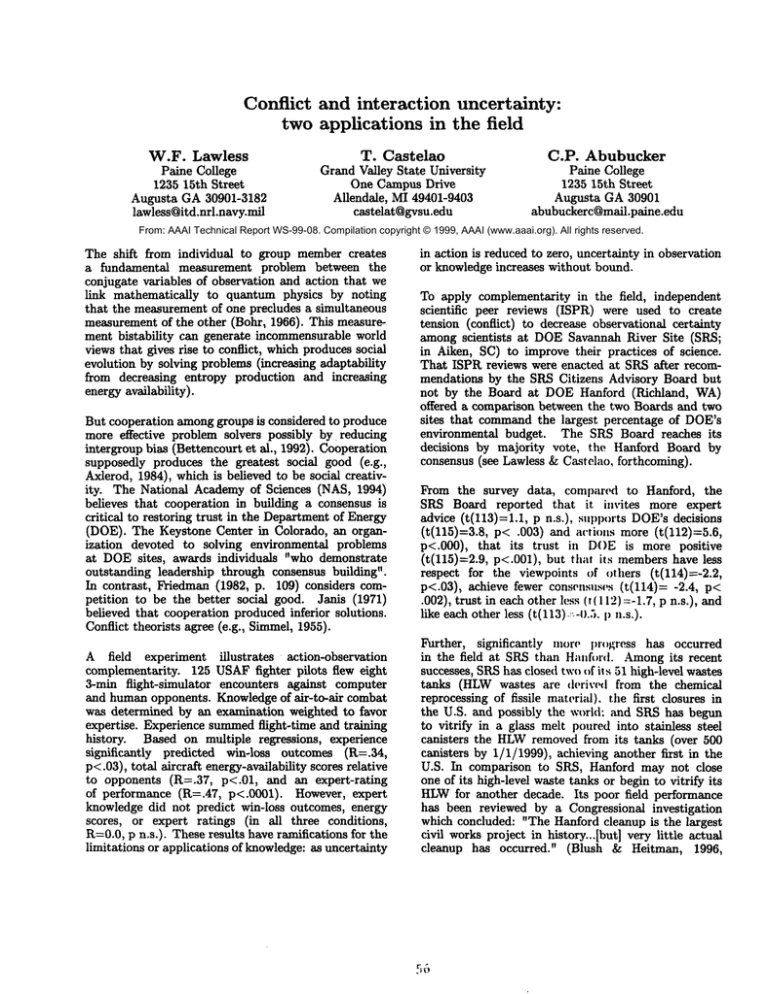
Conflict and interaction
uncertainty:
two applications in the field
W.F. Lawless
T. Castelao
Paine College
1235 15th Street
Augusta GA 30901-3182
lawless@itd.nrl.navy.mil
Grand Valley State University
One Campus Drive
Allendale, MI 49401-9403
castelat@gvsu.edu
C.P. Abubucker
Paine College
1235 15th Street
Augusta GA 30901
abubuckerc@mall.paine.edu
From: AAAI Technical Report WS-99-08. Compilation copyright © 1999, AAAI (www.aaai.org). All rights reserved.
The shiftfrom individual
to groupmembercreates
a fundamentalmeasurementproblembetween the
conjugate
variables
of observation
andactionthatwe
link mathematically
to quantumphysicsby noting
thatthemeasurement
of oneprecludes
a simultaneous
measurement
of the other(Bohr,1966).Thismeasure
mentbistability
can generate
incommensurable
world
viewsthatgivesriseto conflict,
whichproduces
social
evolution
by solving
problems
(increasing
adaptability
fromdecreasing
entropyproduction
and increasing
energy availability).
in action
isreduced
tozero,uncertainty
in observation
or knowledge
increases
without
bound.
To apply complementarity in the field, independent
scientific
peer reviews (ISPR) were used to create
tension (conflict) to decrease observational certainty
among scientists
at DOESavannah River Site (SITS;
in Aiken, SC) to improve their practices of science.
That ISPR reviews were enacted at SItS after recommendations by the SRS Citizens Advisory Board but
not by the Board at DOEHanford (Richland,
WA)
offered a comparison between the two Boards and two
sites that commandthe largest percentage of DOE’s
Butcooperation
amonggroupsis considered
to produce
moreeffective
problemsolverspossiblyby reducing
environmental budget. The SRS Board reaches its
intergroup
bias(Bettencourt
et al.,1992).
Cooperation decisions by majority vote, the Hanford Board by
consensus (see Lawless & Castelao, forthcoming).
supposedly
produces
the greatest
socialgood(e.g.,
Axlerod,
1984),
whichis believed
to be social
creativity.The NationalAcademyof Sciences(NAS,1994)
From the survey data, compared to Hanford, the
believes
thatcooperation
in building
a consensus
is
SRS Board reported that it invites
more expert
critical
to restoring
trustin theDepartment
of Energy
advice (t(l13)=l.1, p n.s.), supports DOE’sdecisions
(DOE).The KeystoneCenterin Colorado,
an organ(t(115)=3.8, p< .003) and actions more (t(112)=5.6,
izationdevotedto solvingenvironmental
problems
p<.000), that its trust in DOEis more positive
at DOE sites,awardsindividuals
"who demonstrate
(t(115)=2.9, p<.001), but that its members have
outstanding
leadership
throughconsensus
building". respect for the viewpoints of others (t(114)=-2.2,
In contrast,
Friedman
(1982,p. 109)considers
comp<.03),achievefewerconsensuses
(t(l14)--2.4,
petition
to be the bettersocialgood.Janis(1971)
.002),
trust
in eachotherless(t(112)=-1.7,
p n.s.),
believed
thatcooperation
produced
inferior
solutions. likeeachother
less(t(113)
~:-0.5.
p n.s.).
Conflict
theorists
agree(e.g.,
Simmel,
1955).
Further,significantly
more pr.gress has occurred
A fieldexperiment
illustrates
action-observation in thefieldat SRS thanHanfi~rd.
Amongitsrecent
complementarity.
125 USAFfighterpilotsfleweight
successes,
SRShasclosed
twoof its51high-level
wastes
3-rainflight-simulator
encounters
againstcomputer
tanks (HLW wastesare deriw,dfrom the chemical
and humanopponents.
Knowledge
of air-to-air
combat
reprocessing
of fissile
material),
thefirstclosures
in
was determined
by an examination
weightedto favor
the U.S.and possiblythe world:and SRS has begun
expertise.
Experience
summedflight-time
andtraining
to vitrify
in a glassmeltpouredintostainless
steel
history.Basedon multipleregressions,
experience
canisters
the HLW removedfromits tanks(over500
significantly
predictedwin-lossoutcomes(R=.34,
canisters
by 1/1/1999),
achieving
another
firstin the
p<.03),
totalaircraft
energy-availability
scores
relative U.S. In comparison
to SRS, Hanfordmay not close
to opponents(R--.37,p<.01,and an expert-rating oneof itshigh-level
wastetanksor begintovitrify
its
of performance
(R=.47,p<.0001).However,expert
HLW for anotherdecade.Its poorfieldperformance
knowledge
did not predictwin-lossoutcomes,
energy
has beenreviewedby a Congressional
investigation
scores,or expertratings(in all threeconditions, whichconcluded:
"TheHanfordcleanup
is thelargest
R--0.0,
p n.s.).
Theseresults
haveramifications
forthe
civilworksproject
inhistory...[but]
verylittle
actual
limitations
or applications
of knowledge:
as uncertainty cleanup has occurred."
(Blush & Heitman, 1996,
p.ES-1)
References
Axlerod, R. (1984). The evolution of cooperation. New
York: Basic Books. Bettencourt, B.A., Brewer, M.B.,
Croak, M.R., & Miller, N. (1992). JESP, 28, 301-319.
Blush, S. M. & Heitman, T. H. (1996, March). Hartford
cleanup. U.S. Sen Common Energy.
Bohr, N. 1966. The world of the atom. pp. 1229-1258,
NewYork: Basic. National Academyof Science (NAS).
(1994). Building consensus. National AcademyPress.
Friedman, M. (1982).
Capitalism and freedom.
Chicago: University of Chicago Press.
Janis, I.L. (1971). Groupthink: The desperate drive for
consensus at any cost. Psychology Today.
Lawless, W.F. & Castelao, T. (forthcoming).
IEEE
Transactions on Systems, Man, & Cybernetics.
Simmel, G. (1955). Conflict and the web of group affiliations. NewYork: Free Press.




